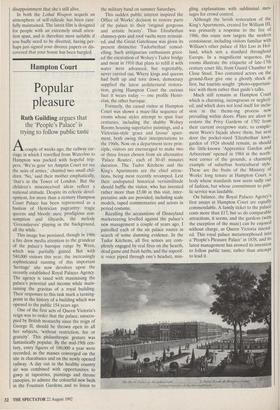Hampton Court
Popular pleasure
Ruth Guilding argues that the 'People's Palace' is . trying to follow public taste Acouple of weeks ago, the railway car- riage in which I travelled from Waterloo to Hampton was packed with hopeful trip- pers. 'We're goin' ter Amptin Court ter see the suits of armer,' chanted two small chil- dren. `No,' said their mother emphatically, `that's in the Tower of London.' But the children's misconceived ideas reflect a national attitude. Despite its eclectic devel- opment, for more than a century Hampton Court Palace has been represented as a bastion of Henrician pageantry: tragic queens and bloody axes; prodigious con- sumption and tiltyards, the melody `Greensleeves' playing in the background, all the while.
This image has persisted, though in 1986 a fire drew media attention to the grandeur of the palace's baroque range by Wren, which was partially gutted. But with 540,000 visitors this year, the increasingly sophisticated running of this important `heritage' site now devolves upon the recently established Royal Palaces Agency. The agency is taxed with maximising the palace's potential and income while main- taining the gravitas of a royal building. Their responses to this task mark a turning- point in the history of a building which was opened to the public 154 years ago.
One of the first acts of Queen Victoria's reign was to order that the palace, unoccu- pied by British monarchy since the reign of George II, should be thrown open to all her subjects, 'without restriction, fee or gratuity'. This philanthropic gesture was fantastically popular. By the mid-19th cen- tury, entry figures of 180,000 a year were recorded, as the masses converged on the site in charabancs and on the newly opened railway. A day out in the healthy country air was combined with opportunities to gawp at tapestries, paintings and throne canopies, to admire the colourful new beds in the Fountain Gardens, and to listen to
the military band on summer Saturdays.
This sudden public interest inspired the Office of Works' decision to restore parts of the palace to their 'original gorgeous and artistic beauty'. Thus Elizabethan chimney-pots and roof vaults were reinstat- ed, and the Great Gatehouse was given its present distinctive `Tudorbethan' remod- elling. Such antiquarian enthusiasm greet- ed the excavation of Wolsey's Tudor bridge and moat in 1910 that plans to refill it with water were advanced, but regrettably, never carried out. Where kings and queens had built up and torn down, democracy supplied the latest architectural restora- tion, giving Hampton Court the curious face it wears today — one profile Henri- cian, the other baroque.
Formerly, the casual visitor at Hampton Court was shown a maze-like sequence of rooms whose styles attempt to span four centuries, including the shabby Wolsey Rooms housing superlative paintings, and a Victorian-style 'grace and favour' apart- ment, both owing their interpretations to the 1960s. Now on a department store prin- ciple, visitors are encouraged to make two or three forays chosen from six alternative `Palace Routes', each of 30-45 minutes duration. The Tudor Kitchens and the King's Apartments are the chief attrac- tions, being most recently revamped. Lest their undisputed historical verisimilitude should baffle the visitor, who has invested rather more than £5.00 in this visit, inter- pretative aids are provided, including scale models, taped commentaries and actors in period costume.
Recalling the accusations of Disneyland marketeering levelled against the palace's new management a couple of years ago, I patrolled each of the six palace routes in search of some damning evidence. In the Tudor Kitchens, all five senses are com- pletely engaged by real fires on the hearth, dead game and fresh herbs, and the soporif- ic voice piped through one's headset, min-
gling explanations with subliminal mes- sages for crowd control.
Although the lavish restoration of the King's Apartments, created for William III, was primarily a response to the fire of 1986, this route now targets the modern connoisseur, including visitors familiar with William's other palace of Het Loo in Hol- land, which sets a standard throughout Europe. In a magnificent sequence, the rooms illustrate the etiquette of late-17th century court life, from Guard Chamber to Close Stool. Two costumed actors on the ground-floor give one a ghostly shock at first, but tourists sought 'photo-opportuni- ties' with them rather than guide's talks. Much still remains at Hampton Court which is charming, incongruous or neglect- ed, and which does not lend itself for inclu- sion in the theme-ing process now prevailing within doors. Plans are afoot to restore the Privy Gardens of 1702 from their current overgrown state, to comple- ment Wren's façade above them, but next door the pocket-sized 'Elizabethan' knot- garden of 1924 should remain, as should the little-known 'Apprentice Garden and Arboretum' opened in 1984 in the north- west corner of the grounds, a charming example of suburban horticultural style. These are the fruits of the Ministry of Works' long tenure at Hampton Court, a body whose standards now seem sadly out of fashion, but whose commitment to pub- lic service was laudable.
On balance, the Royal Palaces Agency's first assays at Hampton Court are equally commendable. A family ticket to the palace costs more than £17, but so do comparable attractions, it seems, and the gardens (with the exception of the maze) can be enjoyed without charge, as Queen Victoria intend- ed. This royal palace metamorphosed into a 'People's Pleasure Palace' in 1838, and its latest management has avowed its intention to follow public taste, rather than attempt to lead it.










































 Previous page
Previous page